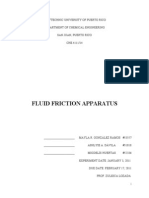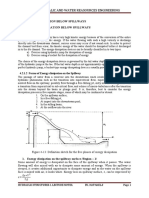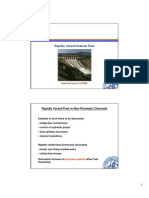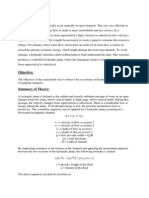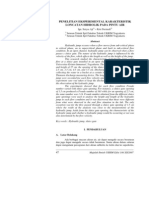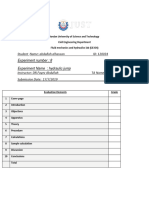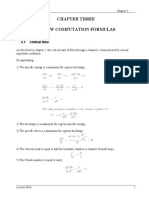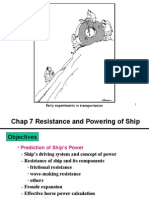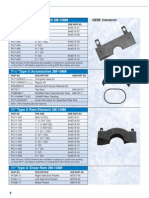Dymamics of Fluid Flow: Specific Energy and Critical Depth
Dymamics of Fluid Flow: Specific Energy and Critical Depth
Uploaded by
Hiren PatelCopyright:
Available Formats
Dymamics of Fluid Flow: Specific Energy and Critical Depth
Dymamics of Fluid Flow: Specific Energy and Critical Depth
Uploaded by
Hiren PatelOriginal Description:
Original Title
Copyright
Available Formats
Share this document
Did you find this document useful?
Is this content inappropriate?
Copyright:
Available Formats
Dymamics of Fluid Flow: Specific Energy and Critical Depth
Dymamics of Fluid Flow: Specific Energy and Critical Depth
Uploaded by
Hiren PatelCopyright:
Available Formats
NPTEL Course Developer for Fluid Mechanics
Module 04; Lecture 34
Dr. Niranjan Sahoo
IIT-Guwahati
DYMAMICS OF FLUID FLOW
SPECIFIC ENERGY AND CRITICAL DEPTH
In open channel flows one of the important parameter is specific energy and is defined
as,
E y
V2
2g
(1)
where y is the water depth and V is the flow velocity. It is also called as energy grade
line (EGL). For a given flow rate, there are two possible states for the same specific
energy as shown in Fig. 1.
Horizontal
hf
E
EGL
Velocity head
y
Fig. 1: Illustrative sketch for specific energy.
In a simpler case, consider two possible states of specific energy in a rectangular
channel of width b . The discharge per unit width for this channel is given by,
q
Q
V .y
b
Eq. (1) can now be written as,
E y
q2
2 gy 2
(2)
For a given channel of constant width, the value of q remains constant along the channel
although the depth y may vary. The variation of q with y is plotted in specific energy
diagram (Fig. 2). From this curve, it is clear that specific energy attains to a minimum
NPTEL Course Developer for Fluid Mechanics
Module 04; Lecture 34
Dr. Niranjan Sahoo
IIT-Guwahati
value at certain depth for a given q . This depth is known as critical depth and it can be
obtained by setting
dE
0 in Eq. (2).
dy
y
Constant q
Sub-critical
yc
Critical
Super-critical
Emin
Fig. 2: Depth verses specific energy curve.
Minimum specific energy occurs at,
1
q 2 3
y yc
g
Q 2
2
b .g
1
3
Emin
3
yc
2
(3)
The velocity of flow at critical depth is known as critical velocity Vc and the
corresponding discharge is qc Vc . yc .
Referring to Fig. 2, for E Emin , no solution exists and thus the flow is unrealistic.
For E Emin , there are two possible solutions;
Large depth with V Vc sub-critical flow.
Small depth with V Vc s called super-critical flow.
Frictionless flow over a bump
Consider an open channel flow over a bump as shown in Fig. 3. The behavior of the free
surface is sharply different based on the approach of the flow; i.e. sub-critical or supercritical. For frictionless two-dimensional flow, sections 1 and 2 are related by
continuity and momentum equation;
NPTEL Course Developer for Fluid Mechanics
Module 04; Lecture 34
y1V1 y2V2 ;
y1
Dr. Niranjan Sahoo
IIT-Guwahati
V12
V2
y2 2 h
2g
2g
Eliminating V2 between the above cubic polynomial equations for water depth y2 over
the bump:
V12 . y12
V12
y E2 y
0 where E2
y1 h
2g
2g
3
2
2
2
(4)
Supercritical approach flow
Subcritical approach flow
V1
y1
V2
y2
Bump
Fig. 3: Frictionless two-dimensional flow over a bump.
y
y1
y2
Sub-critical
bump
hmax (1)
(2)
h
yc
Super-critical
bump
Ec E2
E1
Fig. 4: Specific energy plot for flow over a bump.
Following points may be noted down from the above analysis;
The Eq. (4) has one negative and two positive solutions if h is not too large. Its
behavior is illustrated in Fig. 4 and depends upon whether the point 1 is on the
upper or lower leg of the energy curve.
NPTEL Course Developer for Fluid Mechanics
Module 04; Lecture 34
In sub-critical approach
Fr1 1 ,
Dr. Niranjan Sahoo
IIT-Guwahati
the water level will decrease at the bump
whereas in super-critical approach flows Fr1 1 , the water level will increase
over the bump.
If the bump height reaches hmax E1 Ec , the flow at the crest will be critical
Fr1 1 . In this case,
no physical solution is possible i.e. too large bump will
choke the channel and cause frictional effect, called hydraulic jump.
HYDRAULIC JUMP
A hydraulic jump is a discontinuity when there is a conflict between the upstream and
downstream control parameters in an open channel flow. It occurs, when the upstream
flow is fast and shallow, and the downstream flow is slow and deep and thus provides a
mechanism to make a transition between two types of flow. One such example is flow
under the sluice gate where the downstream portion of the gate (upstream of the channel)
is super-critical flow, while the flow is sub-critical in upstream side (downstream of the
channel).
Consider a simplest type of hydraulic jump that occurs in a horizontal, rectangular
channel as shown in Fig. 5. Take two sections 1 and 2 in upstream and down
streamside where the flow is nearly uniform, steady and one-dimensional. Neglecting the
wall shear stress, the momentum equation can be written as,
F1 F2 Q V2 V1 .V1. y1.b V2 V1
(5)
where b is the channel width. The pressure force at either side is hydrostatic and acts at
the channel cross-sections i.e.
.g .b. y12
.g . y1
F1 pc1. A1
. y1.b
2
2
.g.b. y22
.g. y2
F2 pc 2 . A2
. y2 .b
2
2
(6)
Using Eq. (6) in Eq. (5), we get,
y12 y22 V1. y1
V2 V1
2
2
g
(7)
NPTEL Course Developer for Fluid Mechanics
Module 04; Lecture 34
Dr. Niranjan Sahoo
IIT-Guwahati
hL
Energy line
Control volume
(1)
y1
(2)
V2
F2
V1
y2
Q, F1
Shear stress = 0
Fig. 5: Hydraulic jump geometry.
Similarly, the mass and energy conservation equations can be written for section 1 and
2 respectively i.e.
y1.bV
. 1 y2 .bV
. 2 Q
y1
V12
V2
y2 2 hL
2g
2g
(8)
(9)
The head loss hL is due to violent turbulent mixing and dissipation that occurs within the
jump itself. All Eqs. (7 to 9), are satisfied for y1 y2 ; V1 V2 and hL 0 . It represents a
trivial case when there is no jump. The other possible solution can be obtained by
combining Eqs. (7 and 8) to eliminate V2 i.e.
y12 y22 V1. y1 V1. y1
V12 . y1
V1
y1 y2
2
2
g y2
g . y2
(10)
Simplification of this equation gives,
2
y2 y2
2
2 Fr1 0
y1 y1
where Fr1
(11)
V1
is the upstream Froude number. The possible solution for Eq. (11) is
gy1
y2 1
1 1 8Fr21
y1 2
(12)
NPTEL Course Developer for Fluid Mechanics
Module 04; Lecture 34
Dr. Niranjan Sahoo
IIT-Guwahati
hL
can then be obtained from Eq. (9) as,
y1
The dimensionless head loss,
y
hL
y F2
1 2 r1 1 2
y1
y1
2
y1
(13)
y2
are obtained from Eq. (12) and then
y1
For a given values of Fr1 , the depth ratios
hL
is calculated from Eq. (13). It will be negative if Fr1 1 (since the
y1
the head loss
negative head loss violates second law of thermodynamics). The flow must be supercritical Fr1 1 to produce the discontinuity called as hydraulic jump and there is a
considerable energy loss across the hydraulic jump. This in fact is extremely useful in
many situations; e.g. the relatively large amount of energy contained in the fluid flowing
down the spillway of dam causes damage to the channel below the dam. By placing
suitable flow control objects in the channel downstream spillway, it is possible to produce
hydraulic jump on the apron of the spillway and thereby dissipate a considerable portion
of the energy of the flow i.e. the dam spillway produces super-critical flow and the
channel downstream of the dam requires sub-critical flow. Hence, the hydraulic jump
provides a means to change the character of the flow.
Classification of hydraulic jump
The principal parameter affecting hydraulic-jump performance is Froude number. The
Reynolds number and the channel geometry have the secondary effect. Based on the
Froude number, the hydraulic jumps are classified as;
Fr1 1 : Jump is impossible as it violates second law of thermodynamics.
Fr1 1 to 1.7 : Standing wave or undular jump; low dissipation less than 5%.
Fr1 1.7 to 2.5 : Smooth surface rise known as weak jump; dissipation is 5 to
15%.
NPTEL Course Developer for Fluid Mechanics
Module 04; Lecture 34
Dr. Niranjan Sahoo
IIT-Guwahati
Fr1 2.5 to 4.5 : Unstable, Oscillating jump; each irregular pulsation creates a
large wave which can travel downstream for miles, damaging earth banks and
other structures. Dissipation is 15 to 45%.
Fr1 4.5 to 9 : Stable, well balanced, steady jump; best performance and action,
insensitive to downstream conditions. Dissipation is 45 to 70%.
Fr1 9 : Rough, intermittent strong jump but good performance. Dissipation is 70
to 85%.
UNDERFLOW GATES
These gates are typical structures constructed at the crest of an overflow spillway, or at
the entrance of an irrigation canal/river for controlling the flow rate. Some of the typical
structures are vertical gates (commonly called sluice gate), radial gates, and drum gates.
Water level
Water level
Water level
a
y1
(a)
y2
(b)
(c)
Fig. 6: Underflow gates; (a) vertical gate, (b) radial gate, (c) drum gate.
The flow under the gate is said to be free flow when the fluid issues as a jet of
supercritical flow with free surface open to atmosphere as shown in the Fig. 6. The
discharge per unit width of the gate can be expressed as,
q Cd .a. 2 g . y1
(14)
The discharge coefficient Cd is a function of the contraction coefficient Cc y2 a and
depth ratio y1 a . The typical values of discharge coefficient from a vertical sluice gate
with free out flow are of the order of 0.55 to 0.6.
There are certain situations where the depth downstream of the gate is controlled by
some downstream obstacle. The jet of water issuing from underflow gate is overlaid by
mass of water that is quite turbulent (Fig. 7). Such a gate is known as
NPTEL Course Developer for Fluid Mechanics
Module 04; Lecture 34
Dr. Niranjan Sahoo
IIT-Guwahati
drowned/submerged gate. The flow rate can be obtained from the same equation (Eq. 14)
with appropriate modification in Cd .
Water level
y1
q
y2
Fig. 7: Drowned outflow from a sluice gate.
Flow under a sluice gate
The flow pattern under a sluice gate is shown in Fig. 8. If the flow is allowed free
discharge (Fig. 8-a), then it smoothly accelerates from sub-critical (upstream) to critical
(near the gap) to super-critical (downstream). For free discharge the friction may be
neglected. Applying continuity and momentum equation,
V1. y1 V2 . y2 and
V12
V2
y1 2 y2
2g
2g
(15)
Eliminating V2 , we get
V12
V 2.y2
y1 y22 1 1 0
2g
2g
y23
(16)
Thus, for a given sub-critical upstream flow V1 , y1 , there is only one real solution
i.e. super-critical flow at the same specific energy as shown in Fig. 8-b. The flow rate
y2
y2
2
and reaches to a maximum when . When the depth
3
y1
y1
varies with the ratio
NPTEL Course Developer for Fluid Mechanics
Module 04; Lecture 34
Dr. Niranjan Sahoo
IIT-Guwahati
y2 contracts to 40% less than the gates gap height, the flow pattern is similar to that of a
free orifice discharge and can be approximated in the range
H
0.5 as,
y1
0.61
Q Cd .H .b 2 gy1 where Cd
y1
(17)
1 0.61
If the tail-water is high as in the case of Fig. 8-c, the free discharge is not possible.
The sluice gate is said to be drowned or partially drowned. There will be energy
dissipation in exit flow, in the form of drowned hydraulic jump and the downstream flow
will return to sub-critical. Hence, Eqs (16 and 17) will not be applicable for such
situations and experimental correlations are necessary.
Water level
Sub-critical
y1
V1, y1
Vena contracta
V2, y2
Water level
(1)
V1, y1
V2, y2
(2)
y2
(a)
High tail water
Dissipation
Super-critical
E1 = E2
(c)
(b)
Fig. 8: Flow under a sluice gate; (a) Free discharge; (b) Specific energy for free
discharge; (c) Dissipative flow under a drowned gate.
Example 1
A rectangular channel 6m wide carries 168 lits/min at a depth of 0.9m. What is the height
of a rectangular weir which must be installed to double the depth? Discharge coefficient
of weir may be taken as 0.85.
Solution
The discharge for a broad crested weir is given by,
V 2 2
Q 1.7Cd Lw . H a
2 g
NPTEL Course Developer for Fluid Mechanics
Module 04; Lecture 34
Dr. Niranjan Sahoo
IIT-Guwahati
Here, Q 168 m 3 min 2.8 m3 s ; Lw 6m ; Cd 0.85
Then,
2
V2
Q 3
2.8
3
H a
0.47m
2 g 1.7Cd Lw
1.7 0.85 6
The depth of the flow required = 2 0.9 = 1.8m
The velocity of approach is given by,
Q
2.8
0.26 m s
6 1.8 6 1.8
V2
ha a 0.0034m
2g
H 0.47 0.0034 0.4666m
Va
Height of the broad crested weir = 1.8 0.4666 = 1.3334m.
Example 2
Water flow in a wide channel approaches a 10cm high bump at 1.5m/s. and a depth of
1m. Estimate: (a) the water depth over the bump; (b) the bump height that will cause the
crest flow to be critical. Take the head loss as 0.1m and the flow is frictionless.
Solution
(a) First, the Froude number is calculated as,
Fr1
V1
1.5
0.48
2 gy1
2 9.811
It means that the flow is sub-critical. Take two sections 1 and 2 in the entire length of
the flow (Fig 8).
Specific energy of the flow is,
1.5 1.0 1.115m
V2
E1 1 y1
2g
2 9.81
E2 E1 h 1.115 0.1 1.015m
2
Applying continuity and energy equations,
V1. y1 V2 . y2 and
V12
V2
y1 2 y2 h
2g
2g
Eliminating V2 ,
10
NPTEL Course Developer for Fluid Mechanics
Module 04; Lecture 34
y23 E2 y22
Dr. Niranjan Sahoo
IIT-Guwahati
V12 . y12
V2
0 where E2 1 y1 h
2g
2g
or, y23 1.015 y22 0.115 0
Three real roots of the above equation are, y2 0.86m, 0.45m and -0.29m . The
negative root is physically impossible. For sub-critical conditions, y2 0.86m and for
super-critical condition, y2 0.45m .
The surface level has dropped by y1 y2 h 1 0.86 0.1 0.04m .
The crest velocity, V2
V1. y1 1.5 1
1.745 m s
y2
0.86
The Froude number at the crest is, Fr 2
V2
1.745
0.424 i.e. the flow
2 gy2
2 9.81 0.86
downstream of the bump is sub-critical.
(b) For critical flow, Froudes number is unity at the crest and
1
2
3
3 q 2 3 3 V . y 3 3 1.5
Ec yc 1 1
2
2 g
2 g
2 9.81
1
3
0.918m
Maximum height for the bump, h E1 Ec 1.115 0.918 0.197m
The cubic polynomial equation becomes,
V12 . y12
y Ec y
0
2g
3
2
2
2
or, y23 0.918 y22 0.115 0
The solution is y2 yc 0.61m
The surface level has dropped by y1 yc h 1 0.61 0.197 0.193m
Example 3
Water flows under a sluice gate on a horizontal bed at the inlet to a flume. The water
depth is 50cm in the upstream of the gate and the speed is negligible. At the venacontracta downstream of the gate, the flow streamlines are straight and the depth is 6cm.
Determine the flow speed downstream from the gate and discharge per unit width.
11
NPTEL Course Developer for Fluid Mechanics
Module 04; Lecture 34
Dr. Niranjan Sahoo
IIT-Guwahati
Solution
Referring to the Fig. 13-a, Bernoullis equation can be applied upstream and at the venacontracta of the flow field as,
V12
V2
gz1 2 gz2
2
2
Solving for V2 ,
V2 2 g z1 z2 V12 2 9.81 0.5 0.06 0 2.94 m s
The discharge per unit width is given by,
q
Q
V2 .D2 2.94 0.06 0.1764 m3 s
b
EXERCISES
1. Water flows freely under a sluice gate with upstream depth of 5m and gate opening of
1.5m. Determine: (i) the discharge per unit width; (ii) water depth just upstream of the
gate; (iii) what will be the discharge if the water depth immediately downstream of the
gate is 2m; (iv) compare this value with estimation of discharge under submerged
condition assuming the flow immediately downstream of the gate to be unaffected by
submergence.
2. Water in an open channel flows under a sluice gate. The flow is incompressible and
uniform at two sections 1 and 2 upstream and downstream of the flow respectively.
The depth of water and velocity at the section 1 are 1.5m and 2m/s respectively. The
corresponding values in section 2 are 0.05m and 5m/s respectively. Determine the
direction and magnitude of the hydrostatic force per unit width exerted on the gate by the
flow.
3. Water flows at a rate 10m3/s.m (per unit width) in a wide channel with upstream depth
of 1.25m. If the water undergoes a hydraulic jump, compute the following parameters in
the downstream of the gate: (i) depth of the water; (ii) velocity of the flow; (iii) Froude
number; (iv) head loss; (v) percentage dissipation; (vi) the power dissipated per unit
width; (vii) temperature rise due to dissipation if c p =4.2kJ/kg. K.
12
NPTEL Course Developer for Fluid Mechanics
Module 04; Lecture 34
Dr. Niranjan Sahoo
IIT-Guwahati
4. A rectangular channel with a bottom slope of 1:150 carries water at a rate 20m 3/s.
Determine the width of the channel when the flow is in critical condition. Take
Mannings coefficient as 0.016.
5. In a rectangular canal 3.2m wide is laid with a slope of 0.004. The uniform flow occurs
at a depth of 2m. How much height can the hump be raised without causing transition? If
the upstream depth of flow is to be raised to 2.5m, what should be the height of the
hump? Assume Mannings coefficient as 0.016.
6. Water flows steadily in a rectangular channel laid with a slope of 0.001. The base
width of the channel is 5m and depth of flow is 2m. It is desired to obtain a critical flow
in the channel by providing a hump in the bed. Sketch the flow profile and calculate the
height of the hump required. Take Mannings coefficient as 0.016 for channel surface.
7. A 3.6m wide rectangular channel conveys 10m3/s of water with a velocity of 6m/s.
(i) Is there a condition for hydraulic jump to occur? If so, calculate the height, length and
strength of the jump?
(ii) What is the loss of energy per kg of water?
8. In a rectangular canal of 0.5m width, a hydraulic jump occurs at a point where the
depth of flow is 0.12m and Froude number is 2.5. Determine,
(i) the specific energy; (ii) the critical and subsequent depths; (iii) loss of head; (iv)
energy dissipated.
9. A hydraulic jump occurs in a V-shaped channel with side slope of 45 0. Derive the
expression for flow rate in terms of upstream and downstream depth. If the depths of flow
before and after the jump are 0.4m and 0.8m, determine the flow rate and Froude number
before and after the jump.
10. The depth and velocity of the flow in a rectangular channel are 0.9m and 1.5m/s
respectively. If a gate at the downstream of the channel is abruptly closed, what will be
the height and absolute velocity of the resulting surge? If the channel is 1000m long, how
much time will be required for the surge to reach the upstream end of the channel.
11. A rectangular canal carries a discharge of 1.8m3/s per meter width of the canal. The
energy loss due to a hydraulic jump is found to be 3m. Determine the conjugate depths
before and after the jump.
13
You might also like
- Fluid Friction Apparatus FINAL!!Document71 pagesFluid Friction Apparatus FINAL!!Yara A. Valenzuela Quiros75% (8)
- Hydraulic Jump ExperimentDocument10 pagesHydraulic Jump ExperimentArvin De Lara Sanchez75% (4)
- Lab Report 5. Investigating The Hydraulic JumpDocument12 pagesLab Report 5. Investigating The Hydraulic Jumpfazeen100% (2)
- CH-5 Momentum Principle in OCFDocument20 pagesCH-5 Momentum Principle in OCFAmier ThaqifNo ratings yet
- Rapidly Varied Flow Hydraulic JumpDocument20 pagesRapidly Varied Flow Hydraulic Jumpعبادي العائبNo ratings yet
- De - Referral Hydraulics Lab Sheet Cousework - 2020-21yrDocument14 pagesDe - Referral Hydraulics Lab Sheet Cousework - 2020-21yrM ShakirNo ratings yet
- Aiga 085 - 13 Liquid Oxygen, Nitrogen and Argon Cryogenic Tanker Loading System GuideDocument15 pagesAiga 085 - 13 Liquid Oxygen, Nitrogen and Argon Cryogenic Tanker Loading System GuideFahmi FahreziNo ratings yet
- Lecturenote_1656979581chapter 3 Energy Dissipator (1)Document14 pagesLecturenote_1656979581chapter 3 Energy Dissipator (1)magarasamohammedNo ratings yet
- L14 Open Channel Flow - Part 2 PDFDocument5 pagesL14 Open Channel Flow - Part 2 PDFainaNo ratings yet
- Energy DissipatorDocument41 pagesEnergy DissipatorC_C_871775% (4)
- Chapter - 8 Energy Dissipator - ModifiedDocument16 pagesChapter - 8 Energy Dissipator - Modifiedsulaiman mohammedNo ratings yet
- Ju, Jit, Hydralic and Water Reasources Engineering: Energy Dissipation Below Spillways Energy Dissipation Below SpillwaysDocument14 pagesJu, Jit, Hydralic and Water Reasources Engineering: Energy Dissipation Below Spillways Energy Dissipation Below SpillwaysRefisa JiruNo ratings yet
- Chap 5 HJDocument3 pagesChap 5 HJAdron LimNo ratings yet
- Energy DissipatorDocument41 pagesEnergy DissipatorweynNo ratings yet
- Rapidly Varied Flow in Non-Prismatic ChannelsDocument13 pagesRapidly Varied Flow in Non-Prismatic Channelsrashmithakur1018873No ratings yet
- Lec 20Document12 pagesLec 20Subrata Kumar DattaNo ratings yet
- Hydraulic JumpDocument35 pagesHydraulic JumpAhmad PshtiwanNo ratings yet
- Hydraulic Jumps and Nonuniform Open Channel Flow CourseDocument27 pagesHydraulic Jumps and Nonuniform Open Channel Flow CourseDianne M. DepositarioNo ratings yet
- Experiment (9) : Hydraulic JumpDocument4 pagesExperiment (9) : Hydraulic JumpBatool Al-kharabshehNo ratings yet
- Chap - 3 - HSI (Part 2)Document31 pagesChap - 3 - HSI (Part 2)MitikuNo ratings yet
- Chapt. 4 EditedDocument20 pagesChapt. 4 Editedsamuelhailu853No ratings yet
- Dymamics of Fluid Flow: Uniform Depth Open Channel FlowDocument10 pagesDymamics of Fluid Flow: Uniform Depth Open Channel FlowlawanNo ratings yet
- CFD Simulation of Hydraulic Jump in Triangular Channel Seminar ReportDocument19 pagesCFD Simulation of Hydraulic Jump in Triangular Channel Seminar ReportRanjitDesaiNo ratings yet
- Equations in OCFDocument46 pagesEquations in OCFTheeva RajNo ratings yet
- Mohd Adib Mohd Razi PDFDocument10 pagesMohd Adib Mohd Razi PDFLukman HakimNo ratings yet
- Slug and Pulsating Flow in High Gradient ChannelDocument7 pagesSlug and Pulsating Flow in High Gradient ChannelReza JafarzadNo ratings yet
- Circular Tunnel in A Semi-Infinite AquiferDocument7 pagesCircular Tunnel in A Semi-Infinite AquiferSaeed DelaraNo ratings yet
- Chapter 1Document26 pagesChapter 1hadushNo ratings yet
- Hydraulics JumpDocument2 pagesHydraulics JumpNadarasonMaruthamuthuNo ratings yet
- Lect 05 2020Document8 pagesLect 05 2020Hukry AingNo ratings yet
- Ch9 Non-Uniform Flow in Open ChannelsDocument46 pagesCh9 Non-Uniform Flow in Open ChannelsJosé Luis Nava Hernández100% (2)
- Applications of The Momentum Principle - Hydraulic Jump, Surge and Flow Resistance Open ChannelsDocument44 pagesApplications of The Momentum Principle - Hydraulic Jump, Surge and Flow Resistance Open ChannelsPaula Andrea Espinal100% (1)
- Lecture6 PDFDocument9 pagesLecture6 PDFsantanuNo ratings yet
- Experiment No - 1 Flow Through A Sluice GateDocument11 pagesExperiment No - 1 Flow Through A Sluice Gatesalman40% (5)
- 13 - Transient Fluid FlowDocument20 pages13 - Transient Fluid FlowKangkanNo ratings yet
- Jurnal Karakteristik Pintu AirDocument16 pagesJurnal Karakteristik Pintu AirBujank RangerPutihNo ratings yet
- CH-5 OchhDocument47 pagesCH-5 OchhSegni WandimuNo ratings yet
- Civn7016 Hydraulic Structures: 2. Underflow GatesDocument11 pagesCivn7016 Hydraulic Structures: 2. Underflow GatesAlexander MakaringNo ratings yet
- Fluid MechanicsDocument52 pagesFluid Mechanicsmanneli talpagiriNo ratings yet
- Persamaan Energi Dalam Aliran InternalDocument28 pagesPersamaan Energi Dalam Aliran InternalLativa Putry AFiznaNo ratings yet
- Chapter 1Document16 pagesChapter 1Zebrhan GebremariamNo ratings yet
- CE3611 Lab4 Minor Head LossDocument7 pagesCE3611 Lab4 Minor Head LossLinaNo ratings yet
- Expt 1 - Friction Loses in PipesDocument20 pagesExpt 1 - Friction Loses in PipesFauzi Helmi67% (6)
- 7 Hydraulic JumpDocument44 pages7 Hydraulic JumpYacquub Ali NuurNo ratings yet
- Chapter 1 OPCHDocument7 pagesChapter 1 OPCHgemadogelgaluNo ratings yet
- Experiment 1 - Friction Losses in PipesDocument34 pagesExperiment 1 - Friction Losses in PipesKhairil Ikram33% (3)
- Hydraulic Jump-1Document14 pagesHydraulic Jump-1Manny Anthony Taguba100% (1)
- Experiment 1 - Friction Losses in Pipes-ReportDocument41 pagesExperiment 1 - Friction Losses in Pipes-ReportKhairil Ikram67% (3)
- Chap 4 RVF (Hydraulic Jump)Document34 pagesChap 4 RVF (Hydraulic Jump)Shakilla FaizalNo ratings yet
- CEWB1021 Exp 5Document18 pagesCEWB1021 Exp 5alolqigoNo ratings yet
- Chapter-3: Hydraulic Jump and Its Practical ApplicationsDocument26 pagesChapter-3: Hydraulic Jump and Its Practical ApplicationsahsansaddiqueNo ratings yet
- Hydraulic Jump PDFDocument5 pagesHydraulic Jump PDFS KIRAN KUMARNo ratings yet
- Hydraulic JumpDocument5 pagesHydraulic Jumpmark_madaNo ratings yet
- Hy Jump3Document27 pagesHy Jump3shaymaaNo ratings yet
- Chapter 9 Flow in Open ChannelDocument28 pagesChapter 9 Flow in Open ChannelolescootNo ratings yet
- Lecturenote - 1273258938open Channel Hydraulics Chapter FourDocument26 pagesLecturenote - 1273258938open Channel Hydraulics Chapter Fourermiyas anuloNo ratings yet
- CVEN3002-Hydraulics and Hydrology: Open Channel FlowDocument24 pagesCVEN3002-Hydraulics and Hydrology: Open Channel FlowDulanjaya NayanajithNo ratings yet
- Water Surface ProfilesDocument10 pagesWater Surface ProfilesMagesh KumarNo ratings yet
- Report 8 HydroDocument13 pagesReport 8 HydroAbdallah AlhasanNo ratings yet
- Chapter 3Document15 pagesChapter 3abdu yimerNo ratings yet
- For 5th StandardDocument8 pagesFor 5th StandardHiren PatelNo ratings yet
- TOR of Guj RAMSDocument45 pagesTOR of Guj RAMSHiren PatelNo ratings yet
- GLDC Sor 2011-2012Document5 pagesGLDC Sor 2011-2012Hiren PatelNo ratings yet
- ReservoirDocument1 pageReservoirHiren PatelNo ratings yet
- Amendment 01 - IRC 112 2011, JAN 2014Document1 pageAmendment 01 - IRC 112 2011, JAN 2014Hiren PatelNo ratings yet
- Rate Analysis For ConstructionDocument81 pagesRate Analysis For ConstructionHiren Patel100% (3)
- Gen Tech SpecipicationDocument172 pagesGen Tech SpecipicationHiren PatelNo ratings yet
- Intake WellDocument97 pagesIntake WellHiren PatelNo ratings yet
- Polder Pumps ManualDocument7 pagesPolder Pumps ManualHiren PatelNo ratings yet
- Beyt Dwarka Marine BridgeDocument14 pagesBeyt Dwarka Marine BridgeHiren PatelNo ratings yet
- Estimation of Total PopulationDocument11 pagesEstimation of Total PopulationHiren PatelNo ratings yet
- Is 11485.1985 PDFDocument18 pagesIs 11485.1985 PDFHiren PatelNo ratings yet
- WindDocument70 pagesWindJuan PeraltaNo ratings yet
- Textbook List ConsolidatedDocument52 pagesTextbook List ConsolidatedHiren PatelNo ratings yet
- Is 11485.1985 PDFDocument18 pagesIs 11485.1985 PDFHiren PatelNo ratings yet
- Government of Gujarat: Road and Building Department Capital ProjectDocument3 pagesGovernment of Gujarat: Road and Building Department Capital ProjectHiren PatelNo ratings yet
- Sardarsarovar Narmada Nigam Limited: Sardar Sarovar (Narmada) ProjectDocument2 pagesSardarsarovar Narmada Nigam Limited: Sardar Sarovar (Narmada) ProjectHiren PatelNo ratings yet
- Wingwall StabilityDocument2 pagesWingwall StabilityHiren PatelNo ratings yet
- LMI P063-368TI Dosing PumpDocument2 pagesLMI P063-368TI Dosing PumpMULYADINo ratings yet
- Weld Fittings - Dimensional Specification: Matco-Norca Commercial / Industrial Sales TeamDocument2 pagesWeld Fittings - Dimensional Specification: Matco-Norca Commercial / Industrial Sales Teampanks03No ratings yet
- Hydraulic Power System: For Training Purposes OnlyDocument151 pagesHydraulic Power System: For Training Purposes OnlyTalita Cumi100% (2)
- 39 Mouse-PadDocument1 page39 Mouse-Padzhang_taoNo ratings yet
- SI Heat 4e Chap08 Lecture-1Document80 pagesSI Heat 4e Chap08 Lecture-1Aiena AzlanNo ratings yet
- AME 3253 Aerodynamics Practice v03.0Document3 pagesAME 3253 Aerodynamics Practice v03.0jfishryanNo ratings yet
- Schweissfittings PDFDocument44 pagesSchweissfittings PDFRoberto_PrrNo ratings yet
- Essentials of Turbomachinery in CFD PDFDocument135 pagesEssentials of Turbomachinery in CFD PDFPaladin64No ratings yet
- Flow Meter ManualDocument28 pagesFlow Meter Manualinspiringguru.1100% (1)
- Chapter 1 Objective Type Questions Answers Chemical Engg OP Gupta - pdf.WIIZLQIZlDwzWIk6RnxIQtrUJXi6MT4ODocument85 pagesChapter 1 Objective Type Questions Answers Chemical Engg OP Gupta - pdf.WIIZLQIZlDwzWIk6RnxIQtrUJXi6MT4OPrabhu KalpakkamNo ratings yet
- Roberts 1988Document8 pagesRoberts 1988Mustafa MazanNo ratings yet
- CaravansPlus Mains Pressure Limiting Valve - 350KPADocument1 pageCaravansPlus Mains Pressure Limiting Valve - 350KPAGreg NelsonNo ratings yet
- Basics of Ship ResistanceDocument44 pagesBasics of Ship Resistanceapi-27176519100% (15)
- Aircraft Pneumatic Systems and Air SystemDocument11 pagesAircraft Pneumatic Systems and Air SystemRaihan AkbarNo ratings yet
- JM Clipper BOP PDF CatalogDocument9 pagesJM Clipper BOP PDF CatalogVictorNo ratings yet
- FM Practice Questions 1682618846111Document38 pagesFM Practice Questions 1682618846111Hasan javedNo ratings yet
- NPSH and CavitationDocument1 pageNPSH and CavitationSofiane HalimiNo ratings yet
- Practical 1 Viscosity Report (Group 35)Document31 pagesPractical 1 Viscosity Report (Group 35)Sharath BalachandraNo ratings yet
- Sciencedirect SciencedirectDocument6 pagesSciencedirect Sciencedirectahsikhan007No ratings yet
- Bell Delaware Math Cad ExampleDocument8 pagesBell Delaware Math Cad ExampleMohammed A IsaNo ratings yet
- Pressure VesselDocument31 pagesPressure VesselCkaal74No ratings yet
- Leak Class TestsDocument12 pagesLeak Class TestsZain AlwaliNo ratings yet
- Interaksi Fluida-Struktur Pada Kapal Layar Balap Yacht - Marine Transport - Trimarch - DanieleiDocument1 pageInteraksi Fluida-Struktur Pada Kapal Layar Balap Yacht - Marine Transport - Trimarch - DanieleiDr. Ir. R. Didin Kusdian, MT.No ratings yet
- HDM360S Tutorial 1-2024 - Dimensional Analysis (DA)Document2 pagesHDM360S Tutorial 1-2024 - Dimensional Analysis (DA)smisosphamandla30No ratings yet
- API 570 Practice Questions (Numbers Only) All Questions Are Closed BookDocument3 pagesAPI 570 Practice Questions (Numbers Only) All Questions Are Closed BookMahmoud samahaNo ratings yet
- C700 Oper - Manual, 22786867Document81 pagesC700 Oper - Manual, 22786867diego fernando salgado devia80% (5)
- Dhi-Qar Training P&IDDocument71 pagesDhi-Qar Training P&IDmustafa1989ocNo ratings yet
- Pompa Sumpit R. Pompa 550LPM@15M (DP 80-26 - 3,7KW - 2pole)Document1 pagePompa Sumpit R. Pompa 550LPM@15M (DP 80-26 - 3,7KW - 2pole)Rinaldy AkbarNo ratings yet
